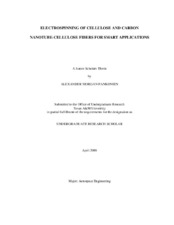| dc.description.abstract | Cellulose is one of the Earth’s most abundant natural polymers and is used as a raw material in various applications. Recently, cellulose based electro-active paper (EAPap) has been investigated for its potential as a smart material. The electrospinning method of fiber production is not a new way of fabrication; however, it has attracted a great deal of attention as a means of producing non-woven membranes of nanofibers due to its simple methodology and the advent of nano applications. Electrospinning occurs when the electrical force on a polymer droplet overcomes its surface tension, and a charged jet is ejected. As the liquid jet is continuously elongated and the solvent is evaporated, the fibers of sub-micron size or nano size are formed, depending on the conditions. In a previous study, a cellulose mat was electro-spun and tested for piezoelectric characteristics. This aligned, electrospun cellulose mat showed a possibility as a promising smart material. Additionally, carbon nanotubes have been considered for the versatile nano-applications due to their superior material properties such as low density and high aspect ratio. Parametric studies were conducted to find optimum conditions for electrospinning. Various ways of reducing surface tension of solutions were investigated including radiative and convective heating of the solution. Pre-examination of solution is very important in consistent, uniform fiber formation.
In this study, cellulose and CNT-cellulose composite fibers were prepared via electrospinning. The optimal experimental conditions for fiber generation were found so that the mechanical strength of both the composite and the pure cellulose fibers could be compared in future tests. Eventually, this fiber will be interwoven into the CNT-cellulose mat and be used as an electro-active paper sensor and actuator. The CNT-cellulose electrospun mat will be widely applicable to the fields of sensors, filters and reinforcements in composites because of its intrinsic properties of porosity, light weight, flexibility, and large surface area. To be used in the aforementioned applications, piezoelectric properties of this composite will also be tested in the next step. | en |


